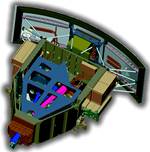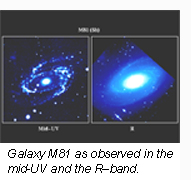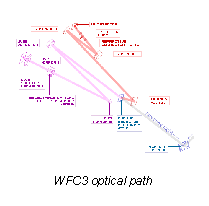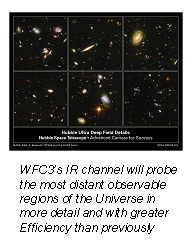 Overview Overview
Instrument Details
Science Details
Overview
The Wide Field Camera 3 (WFC3) will study a diverse range of objects and phenomena,
from early and distant galaxy formation to nearby planetary nebulae, and finally our own
backyard — the planets and other bodies of our Solar System. Its key feature is its
ability to span the electromagnetic spectrum  from near infrared (the kind of radiation seen
with night-vision goggles), through optical light (what our eyes can detect), and into the
near ultraviolet (the kind of radiation that causes sunburn). As such, the WFC3 extends Hubble's
capability not only by seeing deeper into the universe but also by seeing simultaneously into
the infrared and ultraviolet. WFC3 can, for example, simultaneously observe young, hot stars
(glowing predominantly in the ultraviolet) and older, cooler stars (glowing predominantly in
the infrared) in the same galaxy. from near infrared (the kind of radiation seen
with night-vision goggles), through optical light (what our eyes can detect), and into the
near ultraviolet (the kind of radiation that causes sunburn). As such, the WFC3 extends Hubble's
capability not only by seeing deeper into the universe but also by seeing simultaneously into
the infrared and ultraviolet. WFC3 can, for example, simultaneously observe young, hot stars
(glowing predominantly in the ultraviolet) and older, cooler stars (glowing predominantly in
the infrared) in the same galaxy.
WFC3 complements the Advanced Camera for Surveys (ACS), now flying on Hubble, and both will
create the kinds of images the Hubble is known for. The ACS can detect some ultraviolet and infrared
wavelengths, but it is optimized for visible light between blue and red wavelengths. That is, the
sweet spot for ACS is optical, and for WFC3 it is ultraviolet and infrared. Together, WFC3 and
ACS will create the greatest incarnation of the Hubble observatory yet. Moreover, WFC3's ability
to create crisp images of infrared sources makes it a stepping stone to the James Webb Space Telescope,
the successor to Hubble planned for launch next decade. The first stars and galaxies to form in the
universe are so old and distant that their light is now relegated to infrared wavelengths. WFC3 could
bring us at last to this era. the
sweet spot for ACS is optical, and for WFC3 it is ultraviolet and infrared. Together, WFC3 and
ACS will create the greatest incarnation of the Hubble observatory yet. Moreover, WFC3's ability
to create crisp images of infrared sources makes it a stepping stone to the James Webb Space Telescope,
the successor to Hubble planned for launch next decade. The first stars and galaxies to form in the
universe are so old and distant that their light is now relegated to infrared wavelengths. WFC3 could
bring us at last to this era.
WFC3 will replace the Wide Field Planetary Camera 2 (WFPC2), largely an ultraviolet/optical instrument.
In the UV to the blue region of the spectrum, WFC3 will have a 7-16 times advantage over WFPC2 in discovery efficiency (the product of field-of-view and sensitivity)..
+ Back to Top
Instrument Details
When placed on the Hubble Space Telescope, WFC3 will provide unprecedented capabilities for imaging the
cosmos at near-ultraviolet (200-1000 nm) and at near-infrared (800-1700 nm) wavelengths. It will complement
the ACS already on board, which is optimized for visible wavelengths. Together, the two cameras will provide
the observatory with  "panchromatic" imaging of extraordinary sensitivity, accuracy and resolution
over wide fields-of-view. The WFC3 also provides a capable backup to the ACS at visible wavelengths, should
the latter suffer any operational failures. The ACS was mounted on Hubble during Servicing Mission 3B in March 2002. "panchromatic" imaging of extraordinary sensitivity, accuracy and resolution
over wide fields-of-view. The WFC3 also provides a capable backup to the ACS at visible wavelengths, should
the latter suffer any operational failures. The ACS was mounted on Hubble during Servicing Mission 3B in March 2002.
WFC3 is a facility instrument being developed jointly by the Hubble Program at the Goddard Space Flight
Center, the Space Telescope Science Institute in Baltimore, and Ball Aerospace & Technologies Corporation
in Boulder, Colorado. A community-based Science Oversight Committee, led by Prof. Robert O'Connell of the University
of Virginia, provides scientific guidance for its development.
WFC3 is configured as a two-channel instrument. Its wide wavelength coverage with high efficiency is made
possible by this dual-channel design using two detector technologies. The incoming light beam from the Hubble
telescope is directed into WFC3 using a pick-off mirror, and once within the instrument is directed to either the
Ultraviolet-Visible (UVIS) channel or the Near-Infrared (NIR) channel. The  light-sensing detectors in both channels
are solid-state devices. For the UVIS channel, a large format Charge Coupled Device (CCD), similar to those found in
digital cameras, is used. In the NIR detector, the crystalline photosensitive surface is composed of mercury,
cadmium and tellurium (HgCdTe). light-sensing detectors in both channels
are solid-state devices. For the UVIS channel, a large format Charge Coupled Device (CCD), similar to those found in
digital cameras, is used. In the NIR detector, the crystalline photosensitive surface is composed of mercury,
cadmium and tellurium (HgCdTe).
The high sensitivity to light of the 16 megapixel UVIS CCD, combined with a relatively wide field of view
(160x160 arc-seconds), yields approximately a 35-times improvement in discovery power versus HST's current most
sensitive ultraviolet imager, the ACS High-Resolution Channel. The NIR channel's HgCdTe detector is a highly
advanced and larger (one megapixel) version of the 65,000 pixel detectors in Hubble's current near-infrared instrument,
NICMOS. The combination of field-of-view, sensitivity, and low detector  noise results in a 15-20x enhancement in
capability for WFC3/IR over the currently operating NICMOS Camera 3. An important design innovation for the WFC3 NIR
channel results from tailoring its detector to reject infrared light (effectively "heat") longer in wavelength
than 1700 nm. In this way it becomes unnecessary to use a cryogen (e.g. liquid or solid nitrogen) to keep it cold.
Instead, the detector is chilled with an electrical device called a Thermo-Electric Cooler (TEC). This greatly simplifies
the design and will give WFC3 a longer operational life. noise results in a 15-20x enhancement in
capability for WFC3/IR over the currently operating NICMOS Camera 3. An important design innovation for the WFC3 NIR
channel results from tailoring its detector to reject infrared light (effectively "heat") longer in wavelength
than 1700 nm. In this way it becomes unnecessary to use a cryogen (e.g. liquid or solid nitrogen) to keep it cold.
Instead, the detector is chilled with an electrical device called a Thermo-Electric Cooler (TEC). This greatly simplifies
the design and will give WFC3 a longer operational life.
+ Back to Top
Science Details
A major area of science for which WFC3, working in tandem with ACS, is perfectly suited is the study of
how galaxies have formed and evolved over cosmic time. Galaxies in which bursts of new star formation are
occurring emit most of their light at ultraviolet and visible wavelengths. The structure of nearby galaxies
is clearly seen in visible and ultraviolet light. However, looking farther out across the universe and farther
back in time, astronomers see that light shifted farther and farther toward red and near-infrared wavelengths.
The expansion of the universe stretches the wavelength of light. A young proto-galaxy in the early universe blazes
strongly in ultraviolet light. By the time that light has reached us 12 to 13 billion years later, however, its
wavelength has been stretched ("red-shifted") by a factor of 6 to 7 or more. We "see" it predominately in the near infrared. With panchromatic imaging, astronomers will be able to follow the course of galaxy evolution backward in time from our nearest neighboring galaxies all the way out to the earliest times when galaxies had just begun to form.
The wide field of view and clear resolution of WFC3 will  enable astronomers to sort out in detail the various
populations of stars in nearby galaxies to learn when they were formed and what their chemical composition is.
Such observations provide clues to the internal history of individual galaxies. They sometimes also reveal a
history of collisions and mergers between galaxies. enable astronomers to sort out in detail the various
populations of stars in nearby galaxies to learn when they were formed and what their chemical composition is.
Such observations provide clues to the internal history of individual galaxies. They sometimes also reveal a
history of collisions and mergers between galaxies.
The WFC3 will serve as a pathfinder for the much larger infrared telescope, JWST, to be launched in 2013.
Deep time exposures of the distant universe already obtained with Hubble's current cameras reveal numerous, unresolved
(or barely resolved) red objects whose colors indicate that they are young proto-galaxies that emitted their light
when the universe was a billion years old or younger. It will take the larger aperture and greater sensitivity of the
JWST to study the nature of these young proto-galaxies. However, Hubble with WFC3 will guide the way, providing a
survey of promising targets for its larger descendent.
The most astonishing discovery to date from Hubble, in a collaboration with ground-based telescopes, is that the
expansion of the universe at the present time, and for the past 4 to 5 billion years, has been speeding up — not
slowing down as scientists had expected. Hubble's ability to make these observations comes from being able to efficiently
 discover a certain type of exploding star, or supernova, in distant galaxies and to accurately measure its light output
during and after the explosion. These "Type Ia" supernovae (SN Ia) are very consistent in the amount of light
they put out, and thus are well calibrated "standard candles." Their apparent brightness provides a direct and
accurate measure of the distance to the galaxies in which they occur. discover a certain type of exploding star, or supernova, in distant galaxies and to accurately measure its light output
during and after the explosion. These "Type Ia" supernovae (SN Ia) are very consistent in the amount of light
they put out, and thus are well calibrated "standard candles." Their apparent brightness provides a direct and
accurate measure of the distance to the galaxies in which they occur.
With spectrographs that spread the light out into its component colors (or with broad-band camera filters that do
the same job more crudely) astronomers can also measure how rapidly each galaxy is moving away from us due to the general
expansion of the universe. These two numbers — distance and recessional velocity — provide a measure of how
rapidly the universe was expanding at the time each supernova exploded. The accumulation of large numbers of supernova
observations of this kind has provided compelling evidence that the expansion rate  decelerated for the first 9 billion
years or so after the Big Bang, but subsequently began to speed up. Astronomers and physicists are baffled about the
nature of the apparent "negative gravity" that currently wins the competition with ordinary gravity in driving
the acceleration of the universe. They have given it the name "dark energy" and have noted its similarity to
the "cosmological constant" that Albert Einstein originally introduced into the equations of general relativity
to force the universe to be static. That was prior to Edwin Hubble's discovery that the universe is not static, but is in
fact expanding. decelerated for the first 9 billion
years or so after the Big Bang, but subsequently began to speed up. Astronomers and physicists are baffled about the
nature of the apparent "negative gravity" that currently wins the competition with ordinary gravity in driving
the acceleration of the universe. They have given it the name "dark energy" and have noted its similarity to
the "cosmological constant" that Albert Einstein originally introduced into the equations of general relativity
to force the universe to be static. That was prior to Edwin Hubble's discovery that the universe is not static, but is in
fact expanding.
Several concepts for future space missions to further explore dark energy and the acceleration of the universe are
presently being considered. However, knowing so little about the phenomenon, how do we guide these missions to make the
most relevant measurements---to ask the right questions?
Already, the combination of the ACS and Hubble's Near Infrared Camera and Multi-Object Spectrometer (NICMOS) have made major contributions to reducing the uncertainties in measurements of the strength of dark energy. The key questions for the immediate future focus on making such measurements statistically even more precise and determining if dark energy is a constant or varies in magnitude with time. Attacking these questions requires a capability to search the sky for Type Ia supernovae in visible light and to measure their light output at near-infrared wavelengths with great efficiency, so that large numbers of supernovae can be added to the data set. The combination of ACS plus the Near-Infrared channel of WFC3 used in systematic surveys for these supernovae can improve the discovery efficiency by a factor of 2 to 3 over our current capabilities. Is dark energy equivalent to Einstein's cosmological constant and is it truly a constant? Those are questions that WFC3 can plausibly help answer.
Back to Top |